Puntarenas, Costa Rica
January 31st, 2006
09º 58.95' N, 084º 47.81' W
Horizons and I are now sitting somewhat comfortably and safely in the mooring area of the Costa Rica Yacht Club in Puntarenas, on the mainland side of the Gulf of Nicoya. It’s been a relatively active several weeks since my time in Playas del Coco. My stitch- challenged genoa leech tape has been restitched and various other maintenance items having been taken care of.
One of my spare jibs, called a Yankee by salty types, got me to Puntarenas from Playas del Coco, in the absence of my ailing genoa (see one of my earlier postings). This Yankee sail is a much smaller jib and is cut quite high above the deck. It is designed to be deployed along with the staysail, which is also a small jib carried a little behind the Yankee. The Yankee and staysail together don’t provide as much power as my big genoa. But they are better suited to stronger winds, when a full genoa would be too much sail area to carry.
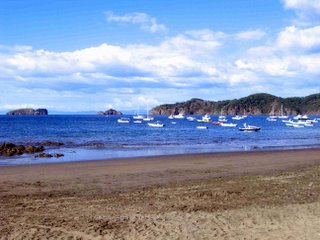
While I remained at anchor at Playas del Coco, Philip, of Carina, again controlled the bosun’s chair halyard and helped me to reinstall the set screws in the forestay extrusion tubes. I was then able to put the Yankee onto the roller furling gear and roll it up – a relatively simple job. Except that I then discovered that I needed to make a pennant (connecting line) to connect the head (top) of the sail with the furling gear swivel near the top of the mast as the Yankee’s luff (leading edge of the sail) was about four feet shorter than the luff of the genoa.
I ended up making a temporary pennant from some spare rope, which performed well until I got to Puntarenas. After receiving needed parts brought from Canada by my Christmas visitor, Tony, and with help from Dwight (of Mira) and his crimping press, I was able to make a proper wire pennant.

(This paragraph is for boaters only. Other readers can jump directly to the next paragraph.) Another consequence of all my trips to the top of the mast was that I discovered that the professional (in the sense that they did this job for money) riggers in Vancouver who originally had installed my roller furling gear had installed one of the components incorrectly. In brief, the halyard wrap stop component (the black round object near the top of the photo) is supposed to be installed near the top of the forestay extrusions in such a position that the blue coloured link plate attached to the swivel (which holds the top of the sail) is adjacent to it, to prevent the halyard attached to the link plate on the swivel housing from wrapping around the forestay when the sail is being furled (rolled up). The riggers who installed my furling gear fitted the halyard wrap stop device about twelve inches too high. The link plate therefore is too low when the halyard is tightened and can’t be raised any higher. It can’t connect with the halyard wrap stop device. Therefore, it is the knot in the halyard which is adjacent to the wrap stop device performing the wrap stop function rather than the link plate.
I liked Playas del Coco, particularly for the wide variety of things in its we
 ll stocked supermarket. The anchorage was a bit rolly from time to time, but I didn’t get too wet landing on the beach through the surf in my dinghy. Security is a problem in Costa Rica, so I chained the dinghy to a palm tree each time I went to shore. I also carried my oars with me rather than leaving them in the dinghy, which was rather less than convenient. But the guy in the Internet café let me leave the oars in his care until I was ready to row back to the boat.
ll stocked supermarket. The anchorage was a bit rolly from time to time, but I didn’t get too wet landing on the beach through the surf in my dinghy. Security is a problem in Costa Rica, so I chained the dinghy to a palm tree each time I went to shore. I also carried my oars with me rather than leaving them in the dinghy, which was rather less than convenient. But the guy in the Internet café let me leave the oars in his care until I was ready to row back to the boat.Just in case any non-cruisers out there are unaware of it, water is very heavy. I carried 15 gallons of it from a tap near the beach to my dinghy on the beach, and then to the tidal line down the beach. The tide was not high. The beach was expansive. Then I dragged my dinghy down to and past the water line. Then I loaded the 15 gallons. Then I dragged the now even heavier dinghy from its water line beach location through the surf into deeper water. Refreshed by these exertions, I then rowed against the wind back to Horizons. Lifting the 15 gallons up to the deck from the dinghy was a minor detail in comparison. I was ready for that first
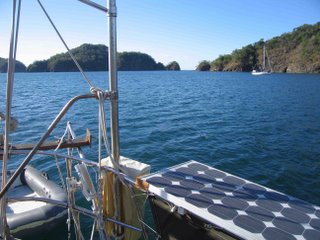 cold beer onboard!
cold beer onboard!Bahia Huevos is a beautiful and peaceful anchorage only about 7 miles from Playas del Coco. That’s where I motored to on December 17th. There was only one other cruising boat anchored there on my arrival. The bay is a haven of tranquility. Only the sounds of the birds, and the howler monkeys on shore. And the sunsets are magnificent.
The water was very clear and it was a good opportunity to dive under the boat for a look-see. The propeller had a lot of tiny barnacles developing, which probably partly accounted for my slow progress under engine power from Playas del Coco. I scraped the three prop blades clean. I also set about doing the same for the rest of the hull, a job I compl
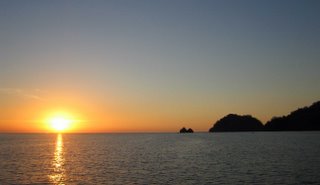 eted the next day. I’ll be really glad when I can get a couple of new coats of anti fouling bottom paint on the hull. Although I suppose I need the exercise, scraping the hull is quite tiring work. But a few cold beers and nibblies are good reward after it’s done.
eted the next day. I’ll be really glad when I can get a couple of new coats of anti fouling bottom paint on the hull. Although I suppose I need the exercise, scraping the hull is quite tiring work. But a few cold beers and nibblies are good reward after it’s done.The next day, a number of other cruising boats began showing up, until the total numbered seven. December 18th is also my father’s birthday. He reached h
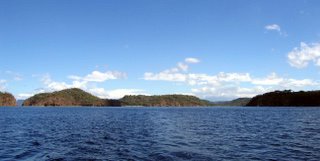 is 86th this year. So I was able to toast his health during Happy Hour. I hope that he had more energy than me on that day. I had defrosted some fish for dinner, but fell asleep at the dinette table before I had a chance to cook it. As I said, scraping the hull is quite tiring work.
is 86th this year. So I was able to toast his health during Happy Hour. I hope that he had more energy than me on that day. I had defrosted some fish for dinner, but fell asleep at the dinette table before I had a chance to cook it. As I said, scraping the hull is quite tiring work.Huevos is the Spanish word for eggs. Bahia Huevos is named for a couple of egg shaped islets at its entrance. The next morning, after having scrambled huevos on toast, I upped anchor and motored to another nearby anchorage. Playa Panama is only 6 miles from Bahi
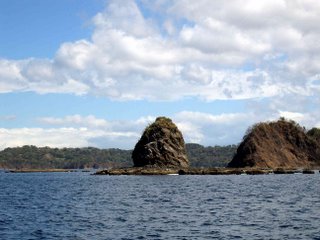 a Huevos. I had rounded the prominent islet rock of Viradores Norte and was making good progress at about 5.5 knots for a short time (what a difference a clean propeller makes) when a squally headwind of about 20 – 25 knots was suddenly in my face along with disagreeable and most unhelpful waves, dropping my speed down to about 3 knots – and occasionally to 2 knots. Fortunately, it wasn’t far to the anchorage. The wind whistled through the anchorage for a while, but the water was calm and the holding for the anchor was good.
a Huevos. I had rounded the prominent islet rock of Viradores Norte and was making good progress at about 5.5 knots for a short time (what a difference a clean propeller makes) when a squally headwind of about 20 – 25 knots was suddenly in my face along with disagreeable and most unhelpful waves, dropping my speed down to about 3 knots – and occasionally to 2 knots. Fortunately, it wasn’t far to the anchorage. The wind whistled through the anchorage for a while, but the water was calm and the holding for the anchor was good.There is some development around the bay at Playa Panama, with a condominium complex on the north edge and some small but modest and discrete tourist clusters, mostly hidden in the trees. So it lacked the serenity and isolation of Bahia Huevos. B
 ut it was quite protected from north and east winds although totally open from the west.
ut it was quite protected from north and east winds although totally open from the west.The Christmas spirit was something I had not yet gotten into, in spite of it only being a week to go. One of the advantages of cruising is that you never get into the annual shopping mall Christmas frenzy. Temperatures in excess of 30º C in palm tree environments also don’t promote the traditional festive mood. So when my cassette stereo player became brain dead, I was considering e-mailing my soon-to-arrive visitor from Canada, Tony, that he would be pleased to know that he would not have the benefit of my Christmas tapes during his stay. So it would indeed be a silent night. However, I did experiment with a hand held cassette recorder coupled to a pair of computer external speakers. It worked, in a sense. But I decided not to be cruel and retired the arrangement without any further word.


1 Comments:
Skipper Bob, I did a search for Moonsong and found your blog. I would like to contact Nola and Jerry. Do you know where they are now and if they have contact information. I have been out of touch with them for quite a few years. My contact e-mail is jcarroll@vei.net.
Jim Carroll
Olympia, WA
Post a Comment
<< Home